 They don’t call it the All Chiefs gathering any more, but it’s still all talk.
They don’t call it the All Chiefs gathering any more, but it’s still all talk.
The third annual summit of the ranking members of the aboriginal leadership and the provincial cabinet is now referred to as the Cabinet-First Nations Leaders Gathering. Whatever the name, there’s a lot more talk at these events than there is action. Not to dismiss the concept entirely — it’s a valuable idea for government and the native leadership to sit down and look each other in the eye from time to time.
But B.C. is long past the time when opening lines of communication can be considered an accomplishment all by itself. It’s time for both sides to start committing to deals in the here and now that can make a difference to blighted reserves and First Nations communities all over B.C.
For all the money that goes into producing the summit, when you look at what came out of the elaborate two-day gathering at the Vancouver convention centre, there isn’t much at hand.
The government considers it an opportunity to continue on the path toward closing the socio-economic gaps. The year since the last talkfest was called a time of progress and partnerships. “We look forward to listening and learning from each other over the course of the gathering so we can continue our important work together.”
Translation: Another year of mostly talk lies ahead. There are worse things that can be imagined. Talk is better than no talk. Meetings at tables are better than confrontations in courtrooms, not that there aren’t a few of those underway. But real action on projects is better than talk.
One tangible development that came out of the summit was the restoration of an acceptable ferry service to Bella Coola. It was torqued as a measure to support aboriginal tourism development, which is showing great promise.
But the ferry upgrade was decided upon two months ago. Announcing it was held off in order to give the government something to deliver at the summit.
There’s also a $680,000 upgrade for Bella Bella Airport and $6 million worth of road work near Bella Coola and Anahim Lake. Good news, but pretty standard fare. Announcing a routine paving job at the summit shows how far they’re reaching for something to deliver.
Also announced at the meeting was a new approach to improve First Nations health and wellness. That’s a worthy, badly needed initiative.
But announcing a new approach isn’t quite the same as actually delivering one. The announcement is simply a recommitment to something signed in March. It involves “facilitating an engagement process” that will include regional meetings full of community dialogue and discussions.
More meetings and more talk, talk, talk.
It’s been three years since the First Nations Health Authority took over administration of care. The agency got rapped by the federal auditor general this year for poor bookkeeping and lack of transparency. But it still seems to be a well-regarded outfit that people desperately want to succeed. All the talk and consultation that was promised this week had better start producing real signs of improvement in care.
Elsewhere on the agenda, the government put up $2.5 million over three years to support an Assembly of First Nations’ economic strategy. It’s going to be spent on round-table talks where development advice is shared, improving employment data about reserves and engaging everyone on economic development in general.
Maybe all that talk will lead to something exciting, some day. But it’s not the same as actually hiring workers, pouring concrete and building something. Real development is happening in some communities, but many are still dormant, stagnant and left out.
Premier Christy Clark’s office started planning these summits in 2014. The event became more significant after the Supreme Court of Canada’s recognition of aboriginal title in a B.C. case. Title and the need for consultation were duly noted. When the 2015 summit rolled around, they were still arguing over exactly how to recognize the decision, and what it meant.
This time around, the talk was more generalized, but the takeaway was the same — lots of talk, not much in the way of real action.


